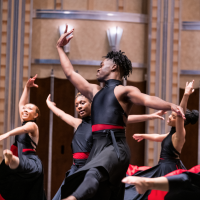That’s what Lily Yeh said about fighting her fears and taking on the challenge of transforming a distressed Philadelphia neighborhood – and the lives of the distressed and forgotten people who lived there.
Lily Yeh is an artist who has worked most of her life to create an alternative world for others from the broken landscapes of the inner city. Her keynote address at the Cleveland Foundation’s Annual Meeting this year was inspiring and filled with more wisdom than a PBS transformative awareness special during pledge week:
“Life breaks us so we have the opportunity to re-make ourselves.”
“We grow our roots in the darkness where we failed.”
“To heal, one must look at the place that hurts.”
“The most challenged place is the one most ready for transformation.”
While we may have heard these or similar aphorisms before, they transmitted deep and powerful truth from a woman whose life has clearly been lived for others and who has found incredible joy and reward in the process. You had to pay attention.
After her keynote, Ms. Yeh stayed in Cleveland to offer a workshop for local grass-roots community workers and artists the next day. Participants came by invitation from the Foundation’s Neighborhood Connections small grants program – and boy, did they come! Registration was capped at 150 and by my count there were more than 100 that showed up on a very rainy day at the neighborhood Senior Center at East 79th and Quincy.
Lily had said the day before that “Community building is very slow and sloppy” but things were far from slow and amazingly well ordered throughout the five hour workshop. It was quite a sight to see 100+ people of all ages, diversities and experience working together by neighborhood (more than 15 Cleveland neighborhoods were represented).
Lily offered a model and a process for neighborhood groups to identify community strengths and weaknesses, create a vision for the future and make sure that every voice was heard and represented. Using color, shape, imagination and a lot of interactive sharing, each group created a symbol and chose a color to represent their neighborhood. With paint and colored markers and lots and lots of big sheets of paper, each group collectively drew a picture, a diagram of their challenges, their current situation and their hope for the future of their community.
It was an enormous amount of work, undertaken in a very short period of time. I was privileged to assist Ms. Yeh and while I learned more than I can say from the experience, one lesson – a technique, actually – will stick with me.
When things got loud or confused and Ms. Yeh (a small woman with a soft voice) needed the group’s attention, she didn’t yell or clap her hands. She started to sing.
“Time to come together, time to come together,” she sang, walking from group to group, taking someone’s hand, encouraging them to sing with her and take another’s hand until everyone was singing “Time to come together,” and had gathered in a big circle. Gentle, respectful, joyful, powerful.
Finally, one of Ms. Yeh’s comments keeps reverberating for me – especially as the news about the Gulf oil spill fills every waking hour of the day. There is a correlation between the waste of people and resources within our cities and the devastation of our irreplaceable oceans. As Lily said, “Maybe some are guilty in catastrophe – but all are responsible.”


